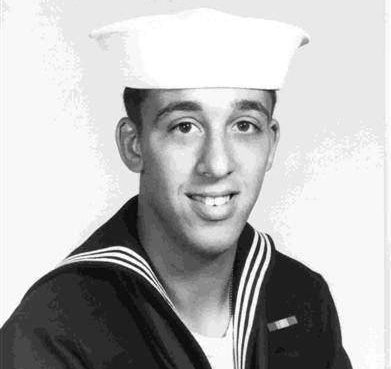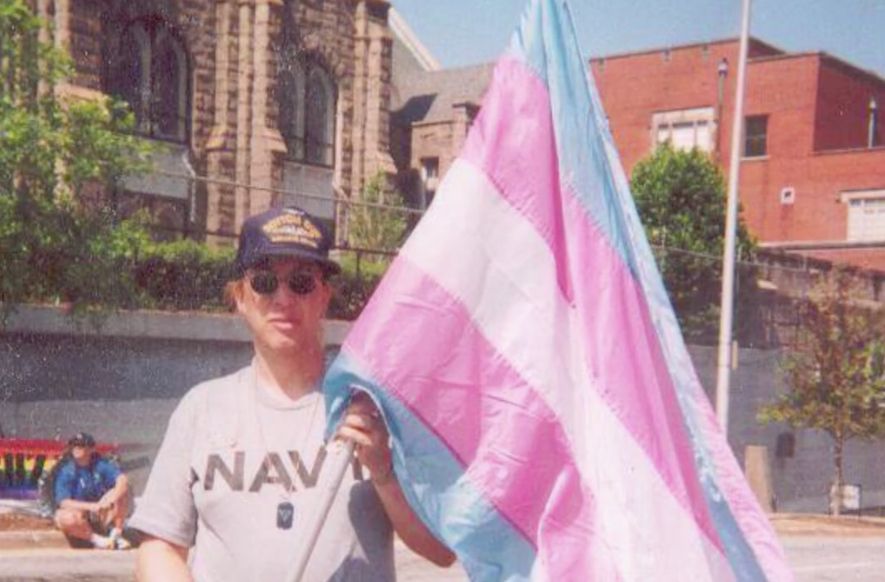Just after 9 a.m. on Wednesday, Monica Helms, like most of the country, read that President Donald Trump had announced on Twitter that transgender individuals would not be allowed to serve in the U.S. military “in any capacity” because the country cannot be “burdened with the tremendous medical costs and disruption that transgender in the military would entail.” (The U.S. military currently spends substantially more money on Viagra than it does on medical care for trans service members.)
But unlike most of the country, Helms is both a proud Navy veteran and a proud transgender woman. She is also the creator of the original pink, white and blue transgender pride flag. For Helms, Trump’s tweets were especially gutting to see, though more disappointing than surprising.
Helms served in the Navy between 1970 and 1978 as a submariner. She joined the service after receiving a low draft number during the Vietnam War, and rather than risk being drafted into the Army, she decided to voluntarily join the Navy. Shortly after, she volunteered to serve on submarines.
“Most people that you talk to say, ‘Oh, gee, I wouldn’t want to do that, I’d be cramped, and I just can’t handle that,’” Helms told HuffPost. “I guess I just had the right personality to be able to handle it. I saw it as an adventure.”

During the 1970s, Helms says she didn’t even know the term “transgender,” and certainly didn’t know that what she was feeling meant that she was a transgender woman. In 1974 she began cross-dressing in secret, hiding certain pieces of herself from her fellow service members. It wasn’t until years after her military service, in 1987, that she realized that she was trans and eventually decided to transition.
Since coming out, Helms has been a passionate advocate for trans rights and specifically for trans visibility in the military. And in 1999, she created the blue, pink and white transgender pride flag. Transilient, a project focusing on trans and gender non-conforming people, in partnership with BuzzFeed sat down with Helms on July 24 ― before the news of the military ban broke ― to talk about her life and what inspired her to create the trans pride flag. Helms, who currently lives in Georgia with her partner, told Transilient that she created the flag in 1999 after meeting Michael Page, the man who created the bisexual pride flag.
“We were talking and [Page] said, ’You know the trans community needs a flag too,” Helms told Transilient. “And all of a sudden the pattern and colors came to me.”
Helms said she made the flag herself and began bringing it with her everywhere, including pride parades and color guard marches. In 2013, she said she started seeing the flag across the U.S. and around the world. The next year, Helms donated the flag to the Smithsonian Design Museum.
Helms also co-founded the Transgender American Veterans Association in 2003, and more recently, she produced a series of four videos ― all of which are posted on YouTube ― about transgender and gender non-conforming veterans throughout American history. (She says she sent links to those videos over to President Trump this morning.)
HuffPost caught up with Helms early Wednesday afternoon to talk about her reaction to President Trump’s announcement, her time in the Navy, and what she would say to the president if she could speak to him today:
HuffPost: Are there any myths about trans people you want to bust?
Monica Helms: Well, all the myths about trans people in the military was the same myth that they liked to pass about gay people in the military. “We can’t handle the job, it’s gonna be too much trouble, what about the bathroom issues...” Geez, I hear the same things over and over and over again.
Was there any discussion of trans people or trans rights at the time that you were serving in the military?
In the 1970s? Oh, heck no. I mean, I didn’t even know what trans was. It wasn’t even a word at the time. I didn’t even realize what I was feeling at the time, what it was. And there’s no way I could have come out, not while I was still in the military.
Did you feel like you had to hide or bury parts of yourself while you were serving?
Oh definitely, yes. It was like, “OK, this is a secret you guys can never know about.”
“The submariners that I met over the years, they’re OK with the fact that I served, and that I’m now a trans woman. I did the same job they did, and even though I’ve changed in this way, all of them have changed as well. So, we’re all shipmates.”
- Monica Helms
Does today’s news change the way that you feel about your own military service at all?
Not at all. I’m very proud of being a submariner. The submariners that I met over the years, they’re OK with the fact that I served, and that I’m now a trans woman. I did the same job they did, and even though I’ve changed in this way, all of them have changed as well. So, we’re all shipmates, as it were. There’s a lot of strength in submariners and in their camaraderie.
Have you met many other transgender Navy veterans over the years?
I have met at least 40 different trans women who were submariners at one time or another. We all had the same stories. It’s like, “Wow, I’m glad nobody found out.” But we’re all proud of our service. It’s one thing that I can always say.
If you could talk to President Trump right now, what would you say to him?
What would I say to him if I was to see him today? “What the hell were you thinking?” Many of our allies [around the world, including Australia, Canada, Israel and the U.K.] have trans people serving openly in their militaries. And they have not had any problems. We did not have any problems when they first allowed transgender service members to be open last year. It just doesn’t make any sense. And even Prince William served directly with a trans woman during his service in the U.K. The woman was even at his wedding.
And what would you say to young trans service members, or young trans people who hope to join the military?
Trump will not be president forever, so keep your hopes up. We will get this back on in the future.
This post has been updated with comments from Monica Helms.
CORRECTION: This article has been updated to reflect that the video interview with Monica Helms was conducted by Transilient.
